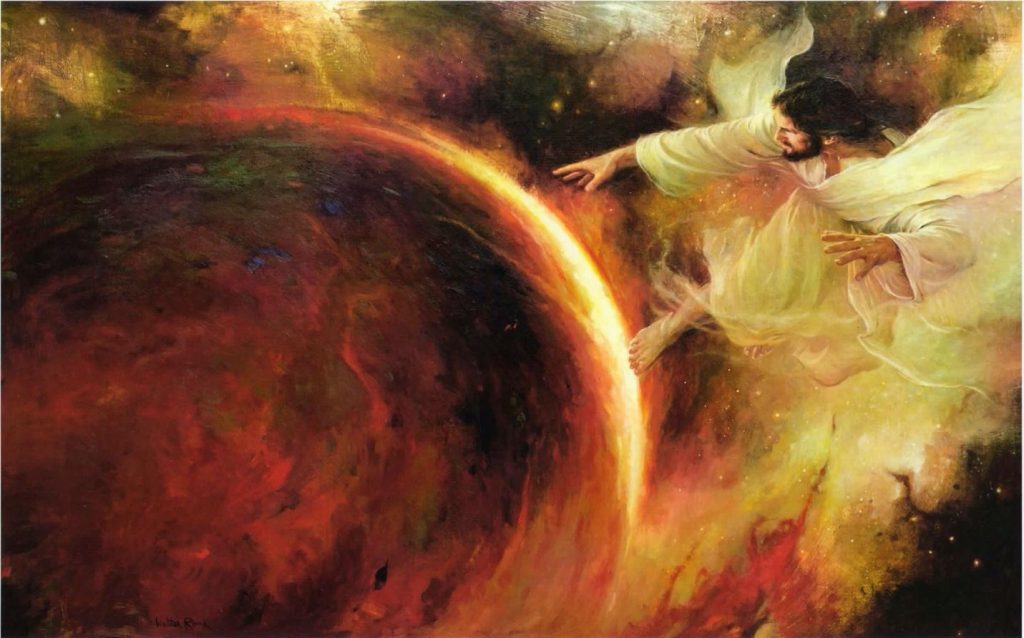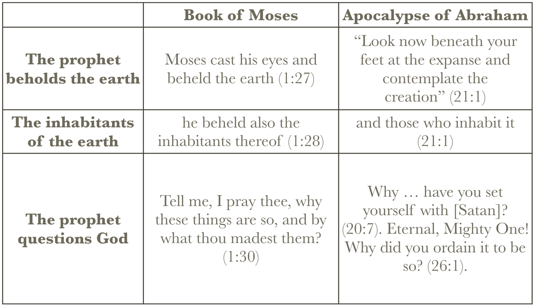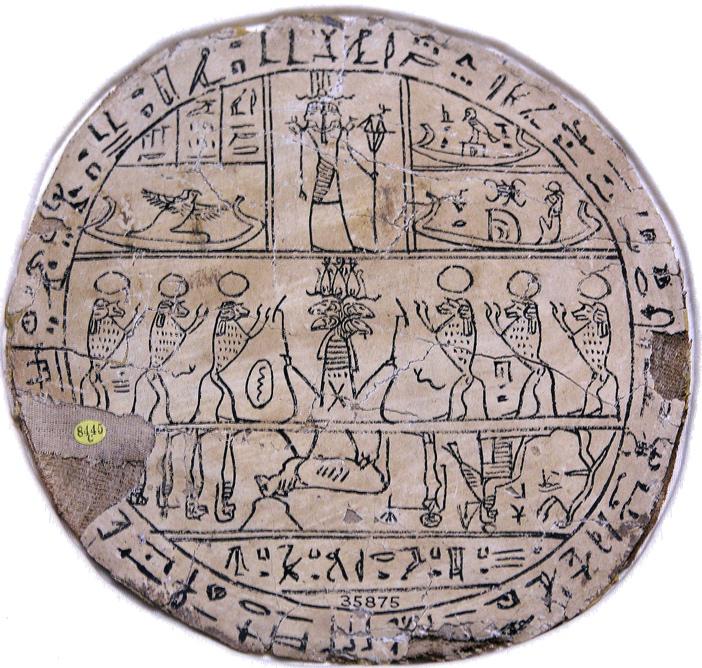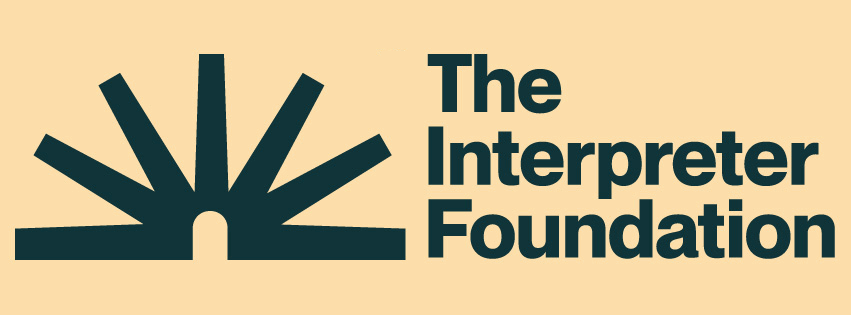This series is cross-posted with the permission of Book of Mormon Central
from their website at Pearl of Great Price Central
Audio Player

Figure 1. Walter Rane, 1949–: Jehovah Creates the Earth, 2000
Having traversed the veil, Moses and Abraham experience a comprehensive vision of the earth and its mortal inhabitants through the ages. In both texts, this raises questions for the prophets, but the nature of the questions differs somewhat in Moses 1 than in the Apocalypse of Abraham (ApAb).

Figure 2. Resemblances for Moses’ Vision at the Veil (Moses 1:27–30)
Moses and Abraham Behold the Earth
The change in perspective as Moses passes upward through the heavenly veil is related in subtle beauty in the Book of Moses. Previously, as Moses stood on the earth, he “lifted up his eyes unto heaven.”[1] Now, after ascending to heaven, he “cast his eyes” down to see the earth and all of its inhabitants.[2] Similarly, Abraham is told: “Look now beneath your feet at the expanse [i.e., heavenly veil[3]] and contemplate the creation and those who inhabit it.”[4]
Significantly, Kulik notes that “Abraham’s exploration of the heavenly world in a downward direction as the heavens open below” is “unique” in the relevant heavenly ascent literature. He writes: “Other visionaries either moved from lower to upper firmaments or wandered in a horizontal direction.”[5] Remarkably, this feature, unique to ApAb in the pseudepigraphal literature, also appears in Moses 1.

Figure 3. Hypocephalus British Museum 35875 (formerly 8445c)
The translation of Rubinkiewicz is stronger than that of Kulik, indicating that Abraham is not merely required to “contemplate” the creation and the inhabitants of the earth, but rather to “pay attention [to] … and understand” it![6] How can Abraham come to understand the universe? In terms that echo the vertical and horizontal divisions of hypocephali such as the one included as Facsimile 2 of the Book of Abraham,[7] Rubinkiewicz explains:[8]
If we pay attention to our account, we will see an astonishing thing. Abraham sees the earth peopled by the wicked (v. 3), but he also sees Eden inhabited by the righteous (v. 6); God shows him the sea ruled by Leviathan (v. 4), but Abraham also contemplates the “upper waters” that are above the firmament (v. 5). At the conclusion, he sees people at the left and right of the picture. What should Abraham understand by this vision? The answer is simple: the division between the righteous and the wicked is based on the structure of the world, where both the forces of evil (the earth and the wicked; the sea and Leviathan) and the forces of good (the “upper waters,” Eden) each have their place. The entire universe has thus been projected by God and “it is pleasing to Him” (22:2).[9]
In other words, as Lehi declared: “it must needs be that there is an opposition in all things” or else “there would have been no purpose in … creation.”[10]
The Inhabitants of the Earth
In their visions, both Moses and Abraham seem to have not only seen the inhabitants of the earth but also witnessed the earth’s entire history from beginning to end—like Adam, Enoch, the Brother of Jared, John the Beloved, and others.[11] Moroni taught that those with perfect faith cannot be “kept from within the veil” (i.e., cannot be kept outside the veil[12]). The veil in question is the heavenly veil behind which God dwells in glory, whose earthly counterpart is the temple veil that divides the holy place from the holy of holies.[13]
Consistent with Jewish,[14] Islamic,[15] and other[16] ancient accounts, Abraham and Moses do not receive their cosmic visions until after they have passed through the heavenly veil. This is because the visions in such accounts, derived from a “blueprint”[17] of eternity that has been worked out before the Creation, are usually described as being depicted inside the heavenly veil.[18] Writes Margaret Barker:[19]
Those who passed beyond the veil found themselves outside time. When Rabbi Ishmael ascended and looked back he saw the curtain on which was depicted past, present and future. ‘All generations to the end of time were printed on the curtain of the Omnipresent One. I saw them all with my own eyes’…[20] [Similarly,] Enoch was taken up by three angels and set up on a high place whence he saw all history, past, present and future.
The heavenly veil corresponding to the firmament of the Creation is sometimes represented as a shining pavement on which the Lord stands[21] or as the “sea of glass” where God resides.[22] Islamic and Jewish sources imply that the unenlightened might mistakenly confuse such a crystal pavement with water.[23] Such descriptions also relate to the white stone that will be given to the Saints “whereby things pertaining to a higher order of kingdoms will be made known.”[24]
Jesus Himself, when He was tempted in the desert saw “all the kingdoms of the world in a moment of time,”[25] an experience that Barker recognizes as “a characteristic of the temple mystics’ overall view of history.”[26] Islamic tradition preserves the same motif in the story of how “Adam took out the cloth and spread it out. Upon it were the forms of the prophets [i.e., the pious] and the pharaohs [i.e., the wicked], rank after rank.”[27]
Moses and Abraham Question God
Now standing in the presence of God, Moses asks about the Creation: “Tell me, I pray thee, why these things are so?”[28] However, in an important divergence from Moses 1, ApAb, Abraham asks two questions of a somewhat different nature, the first about the origin of evil in the world (“Why … have you set yourself with [Satan]?”[29]) and later the other about the origin of evil in humankind (“Eternal, Mighty One! Why did you ordain it to be so?”[30]).
Moses will receive a partial answer to his question about “by what” God made these things through a vision of the Creation.[31] He will also be told something about “why these things are so.”[32]
As with Moses, the answer to Abraham’s first question will be found in his vision of the Creation and the Fall. However, the answer to his second question will come he sees the unfolding of the history of Israel.[33] Scholars, especially those who date this section of ApAb to the years following the destruction of the temple, see the subsequent material as the sort of thing that a first-century redactor might have inserted into a potentially pre-existing heavenly ascent text as a means of providing a plausible context for the theological questions he aimed to answer for his contemporaries.[34]
By way of contrast to ApAb, the questions about Creation posed by Moses are more universal and timeless.[35]
In the mystical Islamic work The Mother of Books, a petitioner also prays with a “typical list of questions”: “My Lord, how did the high king create all these spheres and palaces? From where did he make the spirits? What was the origin of his creation?” and receives an answer similar to the one given to Moses: “The creation of these realms is hard to fathom. Not everyone knows the way to knowledge, and its secret [is] well-concealed.”[36] The Gospel of Philip specifies the mechanism of concealment in asserting that it is the “veil [that] at first concealed how God controlled the creation.”[37]
Conclusion
Joseph Smith may have been alluding to an ineffable experience of seeing behind the veil like that of Moses when he wrote the following to William W. Phelps:[38]
Oh, Lord, when will the time come when Brother William, Thy servant, and myself, shall behold the day that we may stand together and gaze upon eternal wisdom engraven upon the heavens, while the majesty of our God holdeth up the dark curtain until we may read the round of eternity, to the fulness and satisfaction of our immortal souls? Oh, Lord, deliver us in due time from the little, narrow prison, almost as it were, total darkness of paper, pen and ink;—and a crooked, broken, scattered and imperfect language.
We are told that Moses discerned his vision “by the spirit of God.”[39] By this we comprehend that the power behind Moses’ experience was “not just God’s ability to produce a comprehensive vision, but an ability to change Moses so that he could comprehend it.”[40]
This article is adapted from Bradshaw, Jeffrey M., David J. Larsen, and Stephen T. Whitlock. “Moses 1 and the Apocalypse of Abraham: Twin sons of different mothers?” Interpreter: A Journal of Latter-day Saint Faith and Scholarship 38 (2020): 179-290. https://dev.interpreterfoundation.org/moses-1-and-the-apocalypse-of-abraham-twin-sons-of-different-mothers/.
Further Reading
Bradshaw, Jeffrey M. Creation, Fall, and the Story of Adam and Eve. 2014 Updated ed. In God’s Image and Likeness 1. Salt Lake City, UT: Eborn Books, 2014, pp. 62–64. www.templethemes.net.
Bradshaw, Jeffrey M., David J. Larsen, and Stephen T. Whitlock. “Moses 1 and the Apocalypse of Abraham: Twin sons of different mothers?” Interpreter: A Journal of Latter-day Saint Faith and Scholarship 38 (2020): 179-290.
Draper, Richard D., S. Kent Brown, and Michael D. Rhodes. The Pearl of Great Price: A Verse-by-Verse Commentary. Salt Lake City, UT: Deseret Book, 2005, pp. 31–32.
Nibley, Hugh W. “To open the last dispensation: Moses chapter 1.” In Nibley on the Timely and the Timeless: Classic Essays of Hugh W. Nibley, edited by Truman G. Madsen, 1–20. Provo, UT: BYU Religious Studies Center, 1978, p. 12.
Nibley, Hugh W. 1986. Teachings of the Pearl of Great Price. Provo, UT: Foundation for Ancient Research and Mormon Studies (FARMS), Brigham Young University, 2004, pp. 220–223.
References
al-Kisa’i, Muhammad ibn Abd Allah. ca. 1000-1100. Tales of the Prophets (Qisas al-anbiya). Translated by Wheeler M. Thackston, Jr. Great Books of the Islamic World, ed. Seyyed Hossein Nasr. Chicago, IL: KAZI Publications, 1997.
al-Tha’labi, Abu Ishaq Ahmad Ibn Muhammad Ibn Ibrahim. d. 1035. ‘Ara’is Al-Majalis Fi Qisas Al-Anbiya’ or "Lives of the Prophets". Translated by William M. Brinner. Studies in Arabic Literature, Supplements to the Journal of Arabic Literature, Volume 24, ed. Suzanne Pinckney Stetkevych. Leiden, Netherlands: Brill, 2002.
Alexander, Philip S. "3 (Hebrew Apocalypse of) Enoch." In The Old Testament Pseudepigrapha, edited by James H. Charlesworth. 2 vols. Vol. 1, 223-315. Garden City, NY: Doubleday and Company, 1983.
Barker, Margaret. "Beyond the veil of the temple: The high priestly origin of the apocalypses." In The Great High Priest: The Temple Roots of Christian Liturgy, edited by Margaret Barker, 188-201. London, England: T & T Clark, 2003.
———. "The veil as the boundary." In The Great High Priest: The Temple Roots of Christian Liturgy, edited by Margaret Barker, 202-28. London, England: T & T Clark, 2003.
———. Temple Theology. London, England: Society for Promoting Christian Knowledge (SPCK), 2004.
———. The Hidden Tradition of the Kingdom of God. London, England: Society for Promoting Christian Knowledge (SPCK), 2007.
Barnstone, Willis, and Marvin W. Meyer. "The Mother of Books (Umm al-kitab)." In The Gnostic Bible, edited by Willis Barnstone and Marvin Meyer. Translated by Willis Barnstone, 655-725. Boston, MA: Shambhala, 2003.
Bradshaw, Jeffrey M. Creation, Fall, and the Story of Adam and Eve. 2014 Updated ed. In God’s Image and Likeness 1. Salt Lake City, UT: Eborn Books, 2014. www.templethemes.net.
Dan, Joseph. Jewish Mysticism. 4 vols. Northvale, NJ: Jason Aronson, 1998-1999.
Ginzberg, Louis, ed. The Legends of the Jews. 7 vols. Translated by Henrietta Szold and Paul Radin. Philadelphia, PA: The Jewish Publication Society of America, 1909-1938. Reprint, Baltimore, MD: Johns Hopkins University Press, 1998.
Hamblin, William J., and David Rolph Seely. Solomon’s Temple: Myth and History. London, England: Thames & Hudson, 2007.
Isenberg, Wesley W. "The Gospel of Philip (II, 3)." In The Nag Hammadi Library, edited by James M. Robinson. 3rd, Completely Revised ed, 139-60. San Francisco, CA: HarperSanFrancisco, 1990.
Kee, Howard C. "Testaments of the Twelve Patriarchs." In The Old Testament Pseudepigrapha, edited by James H. Charlesworth. Vol. 1, 775-828. Garden City, NY: Doubleday and Company, 1983.
Kulik, Alexander. Retroverting Slavonic Pseudepigrapha: Toward the Original of the Apocalypse of Abraham. Text-Critical Studies 3, ed. James R. Adair, Jr. Atlanta, GA: Society of Biblical Literature, 2004.
———. "Apocalypse of Abraham." In Outside the Bible: Ancient Jewish Writings Related to Scripture, edited by Louis H. Feldman, James L. Kugel and Lawrence H. Schiffman. 3 vols. Vol. 2, 1453-81. Philadelphia, PA: The Jewish Publication Society, 2013.
McConkie, Bruce R. "Christ and the creation." Ensign 12, June 1982, 8-15.
Nibley, Hugh W., and Michael D. Rhodes. One Eternal Round. The Collected Works of Hugh Nibley 19. Salt Lake City, UT: Deseret Book, 2010.
Nibley, Hugh W. 1981. Abraham in Egypt. The Collected Works of Hugh Nibley 14. Salt Lake City, UT: Deseret Book, 2000.
———. 1986. Teachings of the Pearl of Great Price. Provo, UT: Foundation for Ancient Research and Mormon Studies (FARMS), Brigham Young University, 2004.
Nickelsburg, George W. E., ed. 1 Enoch 1: A Commentary on the Book of 1 Enoch, Chapters 1-36; 81-108. Hermeneia: A Critical and Historical Commentary on the Bible. Minneapolis, MN: Fortress Press, 2001.
Rhodes, Michael D. 1997. The Joseph Smith Hypocephalus … Twenty Years Later. In FARMS Prelijminary Report. https://docs.google.com/file/d/0B0LuDGvEmEgJM0g1dkxwRTlqME0/edit. (accessed June 20, 2020).
———, ed. The Hor Book of Breathings: A Translation and Commentary. Studies in the Book of Abraham 2, ed. John Gee. Provo, UT: Foundation for Ancient Research and Mormon Studies, Brigham Young University, 2002.
Rubinkiewicz, Ryszard. "Apocalypse of Abraham." In The Old Testament Pseudepigrapha, edited by James H. Charlesworth. 2 vols. Vol. 1, 681-705. Garden City, NY: Doubleday and Company, 1983.
———. L’Apocalypse d’Abraham en vieux slave : Introduction, texte critique, traduction et commentaire. Towarzystwo Naukowe Katolikiego Uniwersytetu Lubelskiego, Zrodlai i monografie 129. Lublin, Poland: Société des Lettres et des Sciences de l’Université Catholique de Lublin, 1987.
Salisbury, Frank B. The Creation. Salt Lake City, UT: Deseret Book, 1976.
Scholem, Gershom, ed. 1941. Major Trends in Jewish Mysticism. New York City, NY: Schocken Books, 1995.
Smith, Joseph, Jr., Matthew C. Godfrey, Mark Ashhurst-McGee, Grant Underwood, Robert J. Woodford, and William G. Hartley. Documents, Volume 2: July 1831-January 1833. The Joseph Smith Papers, ed. Dean C. Jessee, Ronald K. Esplin, Richard Lyman Bushman and Matthew J. Grow. Salt Lake City, UT: The Church Historian’s Press, 2013.
Smith, Joseph, Jr. 1902-1932. History of the Church of Jesus Christ of Latter-day Saints (Documentary History). 7 vols. Salt Lake City, UT: Deseret Book, 1978.
Thomas, M. Catherine. "The Brother of Jared at the veil." In Temples of the Ancient World, edited by Donald W. Parry, 388-98. Salt Lake City, UT: Deseret Book, 1994.
Wheeler, Brannon M. Prophets in the Quran: An Introduction to the Quran and Muslim Exegesis. Comparative Islam Studies, ed. Brannon M. Wheeler. London, England: Continuum, 2002.
Notes on Figures
Figure 1. https://www.churchofjesuschrist.org/media/image/jehovah-creates-earth-rane-fa3141a?lang=eng (accessed July 6, 2020).
Figure 2. Copyright Jeffrey M. Bradshaw.
Figure 3. Photographs by Stephen T. Whitlock of Hypocephalus of Hor (2005), whose owner may have been “the same as the owner of the Book of Breathings papyrus in the Church collection” (M. D. Rhodes, Joseph Smith Hypocephalus … Twenty Years Later, p. 2), i.e., the source of Facsimiles 1 and 3 of the Book of Abraham (see M. D. Rhodes, Hor). For more on the nature and function of the hypocephalus, see Essay #34, Note on Figure 6.
Endnotes
Come and I will show you the curtain of the Omnipresent One, which is spread before the Holy One, blessed be he, and on which are printed all the generations of the world and all their deeds, whether done or to be done, till the last generation.
Citing precedents in translations of similar visions in Jewish tradition, Kulik translates the relevant term in ApAb 21:2 as a “likeness” or In 22:1, 3, 5; 23:1, and “many other instances” he translates it as “picture” (East Slavic obrazovanie) (A. Kulik, Apocalypse of Abraham, p. 1470 n. 21:2).



Trackbacks/Pingbacks